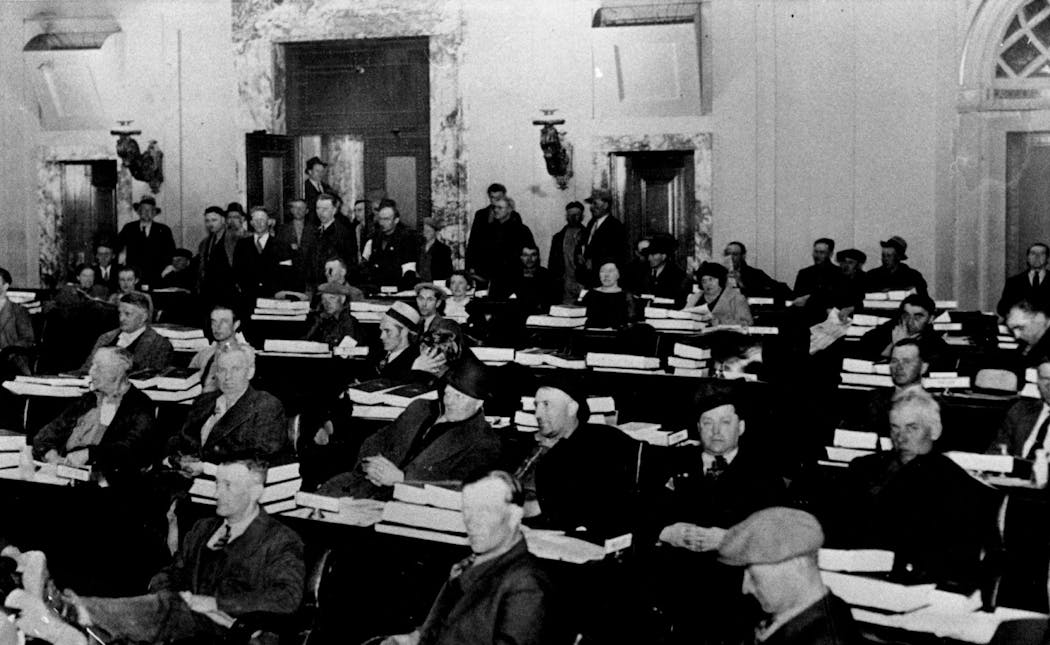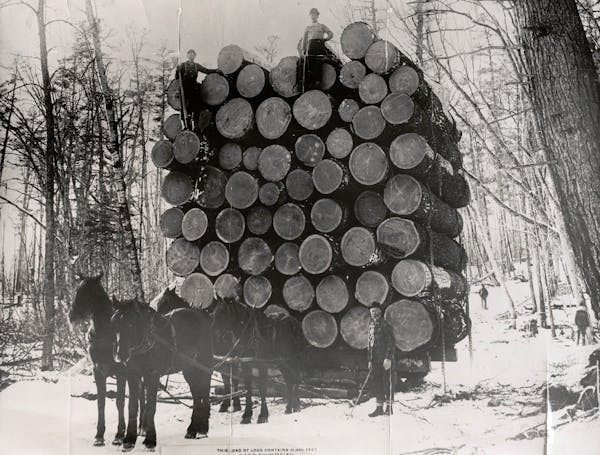What happened during the takeover of the Minnesota State Capitol in 1937?
Listen and subscribe to our podcast: Via Apple Podcasts | Spotify | Stitcher
A fiery populist whipping up protesters.
A Capitol under occupation by angry citizens.
Long before Jan. 6, 2021, came the events of April 4, 1937, when the Minnesota State Capitol was overrun by the People's Lobby, a loose affiliation of labor activists, workers and farmers who'd been coaxed by Gov. Elmer Benson.
The People's Lobby moment (sometimes referred to as the "People's Pilgrimage") has resurfaced after the siege of the U.S. Capitol by supporters of President Donald Trump on the unfounded claims of a stolen election. But the differences matter, says Augsburg University history professor Michael Lansing.
The People's Lobby was "not going in [to overthrow] the formal process of deciding who will be the next president," said Lansing. "They're not going through with the violent defeat of law enforcement."
Moreover, Gov. Benson, a leftist banker from Appleton atop the Farmer-Labor Party, would dismiss associations with the right-wing Trump.
"If he were still alive, [Benson] would hate the comparison," said Anthony Thompson, a retired bank employee from Big Lake, who wrote to the Star Tribune's Curious Minnesota series wanting to know more about the Minnesota Capitol's overnight occupation. "They were on opposite poles politically."
But some similarities remain. Two labor activists would do time for their roles in the 1937 occupation. The incursion even drew sympathizers, given the hopelessness of the Dirty Thirties.
"Everybody was losing their homes," said Clara Jorgensen, a farm activist from Pine County, in a 1974 interview archived by the Minnesota Historical Society. "We'd farm our crops and couldn't sell 'em."
With Minnesotans out of work and farmers enduring years of low commodity prices, political power concentrated in the Farmer-Labor Party.
When the charismatic Farmer-Labor Gov. Floyd B. Olson died of cancer while running for Senate in 1936, the party's second-in-command, Benson, ran for governor and won with 60% of the vote.
Whereas Olson spoke like a radical but governed as a moderate, Benson's actions matched his rhetoric.
Weeks into office, Benson ordered the National Guard to assist striking lumberjacks. He called for higher taxes on wealthy Minnesotans. And he proposed $17 million in unemployment relief.
His one hurdle? The Republican-controlled Senate.
On Sunday, April 4, more than 1,000 people arrived in St. Paul for a rally. After Gov. Benson exhorted the crowd to "get rough," most went home. But about 200 marched to the Capitol.
Someone picked the lock to the Senate chamber. Marchers bumbled in.
"I think what happened was one of the protesters had a knife," said Brian Pease, historic site manger at the Minnesota State Capitol. "There is a way to open that door."
Unlike Jan. 6 insurrectionists, who defecated in the Capitol, ransacked House Speaker Pelosi's desk, and attacked Capitol police, the Minnesotans mostly made themselves comfortable. Some kicked up their boots on desks. They gave speeches, sang labor songs. Drank milk.
"It was a peaceful occupation," said Pease. "There was no intent to do harm to anything or damage property. It was basically like, 'Let's make a statement.' "
In the morning, Gov. Benson told occupiers, "You have accomplished your purpose." Protesters left "empty milk bottles, lunch basket paper, cigarette butts, and piles of refuse" scattered, according to the papers.
The Minneapolis Tribune blasted the occupation as, "orderly government breaking down in state." Republican legislators called for Benson's impeachment.
The governor dismissed criticism as "hysteria." But the Minneapolis Star predicted the events would be "first class campaign material in 1938."
A year later, Benson lost in November to Republican Harold Stassen by 26 points. The $17 million package never became law.
Benson would lose two U.S. Senate races. In the mid 1940s, he and Hubert Humphrey formed the Democratic-Farmer-Labor Party.
Thirty years later, Benson, then hospitalized in Minneapolis, invited a college student he'd been corresponding with to visit him. It was Thompson, the reader who asked Curious Minnesota this question.
"The nurses coming into the room all addressed him as 'Governor,' " Thompson said. On Benson's bed stand: a copy of Chairman Mao's writings.
"I got a kick out of that," Thompson said.
According to Thompson, the old Farmer-Laborite blamed party dissension, big business, and even the liquor lobby for his '38 defeat.
"If you think about it," Thompson told the Star Tribune, "both Trump and Benson are teetotalers."
That — plus a foray into intimidation politics — is where the similarities end.
If you'd like to submit a Curious Minnesota question, fill out the form below:
Read more Curious Minnesota stories:
Why is Minnesota more liberal than its neighboring states?
Why hasn't Minnesota ever produced a U.S. president?
Why does Minnesota have a DFL and not just a Democratic party?
Why was the career of Minnesota's first congresswoman cut short?
When's the last time a Republican won a majority in Minnesota statewide?
Did political shenanigans derail an effort to move Minnesota's capital from St. Paul?
Who was the first woman to serve in the Minnesota Legislature?




